
Int.J.Curr.Microbiol.App.Sci (2018) 7(11): 3042-3048
3042
Original Research Article https://doi.org/10.20546/ijcmas.2018.711.349
Morphological Variations among Different Jackfruit Genotypes
Pebbuli Avani* and F.K. Bauri
Department of Fruits Science, BCKV, Mohanpur 741252, West Bengal, India
*Corresponding author
A B S T R A C T
Introduction
Jackfruit (Artocarpus heterophyllus Lam.), is
a tetraploid (4n=56) and is the one of the most
significant trees in tropical homegardens and
perhaps the most widespread and useful tree in
the important genus Artocarpus, of family
Moraceae. The jackfruit species reportedly
originated in the rainforests of the Western
Ghats of India (Chandler, 1958) and in
Malaysia (Brown, 1941). Jackfruit is a
national fruit of Bangladesh and state fruit of
Kerala and Tamilnadu; where it is commonly
referred to as “poor man’s food” as it is cheap
and plentiful during the season. In India, it has
wide distribution in Assam, Tripura, Bihar,
Uttar Pradesh, the foothills of the Himalayas
and South Indian States of Kerala, Tamil Nadu
and Karnataka.
Jackfruit is a multipurpose tree and all parts of
the plant are equally important. Fruits are rich
in several nutrients. It can act as source of
complete nutrition to the consumer. Fruits of
jackfruit are compared to avocado and olive in
terms of the healthier mix of nutrients for
human dietary needs, almost having the exact
nutrient equivalent of mother's milk. It is rich
in vit-B and C, potassium, calcium, iron,
proteins and high level of carbohydrates,
affordable and readily available supplement to
our staple food. Its seeds are rich in proteins
and can be relished as a nutritious nut. The
fruit is also the source of chemical 'Jacalin'
useful in preventing colon cancer, AIDS
(Priya et al., 2014). Tree is known for its
durable anti-termite timber. Jackfruit trees are
suitable for growing in wide agro-climatic
regions owing to its versatile adaptability,
International Journal of Current Microbiology and Applied Sciences
ISSN: 2319-7706 Volume 7 Number 11 (2018)
Journal homepage: http://www.ijcmas.com
Jackfruit (Artocarpus heterophyllus Lam.), being a cross pollinated crop shows high
variations in plant and leaf characters. Thus, present study was under taken to assess the
morphological variations of plant and leaf characters among twenty genotypes under
AICRP on Fruits, B.C.K.V., Mohanpur centre as per the descriptor developed by
Bioversity International (IPGRI). Variations were noticed with respect to shape of crown
(elliptic, pyramidal, broadly pyramidal, semicircular and irregular), leaf shape (elliptic,
oblong, obovate, narrowly elliptic and broadly elliptic) and also in terms of biometric
characters of fruit like plant height (5.9-9.1m), trunk circumference (0.61-1.17m), crown
diameter (5.1-10.2 m), leaf blade length (7.5-13.4 cm), leaf blade diameter (4.1-7.6 cm),
petiole length (0.7-2.7 cm).
Keywords
Plant characters, Leaf
characters and PCA
(Principle component
Analysis)
Accepted:
22 October 2018
Available Online:
10 November 2018
Article Info

Int.J.Curr.Microbiol.App.Sci (2018) 7(11): 3042-3048
3043
hardy nature, low maintenance cost and high
yield. The trees helps in amelioration of soils
and prevention of the soil erosion. The leaves
and fruit waste provide valuable fodder for
cattle, pigs and goats.
Jackfruit, being cross-pollinated and mostly
seed propagated, jackfruit has innumerable
types or forms in terms of fruit characteristics.
The types differ widely among themselves and
many types available in India under various
local names have originated in this way.
However, distinct cultivars are not available.
Selection of superior genotypes for the fresh
market and the processing industry, as well as
for high yield, better quality and tolerance to
abiotic and biotic stresses, would be of great
value for commercialization of this
underutilized nutritive fruit. Thus, present
study was under taken to assess the
morphological variations among twenty
genotypes under AICRP on Fruits, B.C.K.V.,
Mohanpur centre as per the descriptor
developed by Bioversity International (IPGRI)
Materials and Methods
A study entitled “Morphological variations
among different jackfruit genotypes” was
conducted at AICRP on Fruits, B.C.K.V.,
Mohanpur centre during 2015-2017. Various
morphological characters o jackfruit plant and
leaf were observed in twenty different
genotypes (serially numbered as G-1 to G-20)
as per the descriptor developed by Bioversity
International (IPGRI). The plants were
healthy, about 14 years of age and received
similar cultural treatments.
Plant characters viz., age of the tree, tree
height (m), trunk circumference (cm), trunk
surface, trunk growth habit, crown diameter
(m) and crown shape were recorded on
unpruned plants. Lea characters viz., leaf
blade length (cm), leaf blade width (cm), leaf
blade shape, leaf apex shape, leaf base shape,
leaf blade margin, leaf upper surface
pubescence, leaf lower surface pubescence,
leaf midrib pubescence, petiole length (mm)
and grooves on petiole were recorded by
collecting five leaves from each genotype
from all sides crown.
Principal components were computed from the
correlation matrix and genotypic scores
obtained for the first component and
succeeding components with latent roots
greater than unity (Jager et al., 1983).
Results and Discussion
All 20 genotypes plants selected for present
study were of same age i.e. fourteen (14) years
old. Even with the same age of the genotypes,
differences with regard to plant height were
observed among the genotypes (Table 1). The
maximum plant height of 9.1m was observed
in G-20, followed by G-12 (8.9m) and G-16
(8.8m). The least height of 5.9m was observed
in G-4. Differences in plant height was also
observed by Gaithoiliu et al., (2017) and
found height of different genotypes ranges
from 6.5 m to16 m.
The results of trunk circumference varied
among the genotypes (Table 1), maximum
trunk circumference (1.17m) was recorded in
G-10. The least trunk circumference (0.61m)
was observed in G-4. Grand mean of crown
diameter recorded was 7.42m and showing
variation from 5.1m (G-18) to 10.2m (G-14).
Semi-erect plant growth habit recorded in G-3,
G-5, G-6, G-7, G-8, G-9, G-10, G-11, G-13,
G-14, G-15, G-17, G-18 and G-20 whereas
spreading growth habit observed in G-1, G-2,
G-4, G-12, G-16 and G-19. Two types of
trunk surface (rough and very rough). Among
them 16 showed rough surface (G-1, G-3, G-4,
G-5, G-6, G-8, G-9, G-11, G-12, G-13, G-14,
G-15, G-17, G-18, G-19 and G-20) and 4
recorded very rough (G-2, G-7, G-10 and G-

Int.J.Curr.Microbiol.App.Sci (2018) 7(11): 3042-3048
3044
16). Five crown shapes were noted i.e. elliptic
in G-3, G-4, G-5, G-17; pyramidal in G-1, G-
9, G-11; broadly pyramidal in G-2, G-6; G-8,
10, G-12, G-13, G-14, G-15, G-16, G-20;
semicircular in G-7 and irregular in G-18 and
G-19. Terminal (2012) also reported the
varied plant crown shape like irregular,
oblong, pyramidal, obovate, semicircular,
elliptical and broadly pyramidal in both clonal
and seedling progenies.
The genotypes differed in leaf length and
ranged from 7.5 cm to 13.4 cm for the various
jackfruit genotypes studied (Table 2). The
grand mean leaf length for the genotypes
studied was 10.6 cm. The maximum leaf
length of 13.40 cm was recorded in genotypes
G-13 and G-15 followed by G-11 (12.00cm),
while lowest leaf length (7.5 cm) was recorded
in G-10. Grand mean leaf width was observed
to be 5.7 cm for the jackfruit genotypes
studied, while the leaf width ranged from 4.1
cm to 7.6 cm. The maximum leaf width of 7.6
cm was recorded in G-14, while lowest leaf
width of 4.1 cm was recorded in G-20.
Variation in leaf blade length and width was
also reported in the study of Ruby Khan et al.,
(2010). Five different leaf blade shapes were
noted as elliptic in G-1, G-4, G-6, G-9, G-18,
G-19; oblong in G-8, G-12, G-14, G-17;
obovate in G-3, G-7; narrowly elliptic in G-5,
G-11, G-13, G-15, G-16, G-20 and broadly
elliptic in G-2 and G-10. Similar observations
in conformity to this finding were also
reported by Chandan (2001) with elliptic,
narrowly elliptic, broadly elliptic, obovate,
oblong and lyrate. The shape of the leaf apex
were noted as acute (G-2, G-6, G-7, G-11, G-
13, G-16 and G-20), acuminate (G-1, G-3, G-
4, G-5, G-9, G-15, G-18 and G-19) and obtuse
(G-8, G-10, G-12, G-14 and G-17). Whereas,
four different shape of the leaf apex were
noted as cuneate (G-2, G-3, G-5, G-11, G-13,
G-14, G-15, G-16, G-19 and G-20), shortly
attenuate (G-1, G-7, G-9, G-10, G-12, G-17
and G-18), oblique (G-4 and G-6) and rounded
(G-8). Variation in leaf base shape and apex
shape were also reported in the study of
Chandrasekhar (2014). The leaf margin
observed was undulated (G-1, G-2, G-3, G-4,
G-5, G-7, G-8, G10, G-12, G-13, G-14, G-15,
G-17, G-18 and G-19) and entire (G-6, G-9,
G-11, G-16 and G-20). From the data
represented in Table 2 revealed that leaf upper
surface pubescence showing both sparse (G-1,
G-2, G-3, G-4, G-5, G-8, G-10, G-11, G-12,
G-13, G-14, G-15, G-17, G-18, G-19) and
glabrous (G-6, G-7, G-9, G-16 and G-20).
Leaf lower surface pubescence also showed
both sparse (G-1, G-2, G-3, G-4, G-5, G-7, G-
8, G-9, G-10, G-11, G-12, G-13, G-14, G-15,
G-17, G-18, G-19) and glabrous (G-6, G-16
and G-20). Gaithoiliu et al., (2017) also
reported varied intensity of leaf upper and
surface pubescence. leaf midrib pubescence
showing sparsely pubescence (G-1, G-2, G-3,
G-4, G-5, G-7, G-8, G-10, G-11, G-12, G-13,
G-14, G-15, G-17, G-18, G-19) and glabrous
(G-6, G-16 and G-20). The genotypes differed
in petiole length and the average petiole length
ranged from 0.7 cm to 2.70 cm for the various
jackfruit genotypes studied. The grand mean
petiole length for the genotypes studied was
1.7 cm. Maximum petiole length of 2.70 cm
was recorded in genotype G-14 followed by
G-19 (2.20 cm) and G-15 (2.20 cm), while
lowest petiole length of 0.7 cm was recorded
in G-5. Variation in leaf blade length was also
reported in the study of Wangchu (2005)
ranging 0.08cm (T-4) to 2.50cm (T-27).
Presence of groove, acute crotch angle and
rounded leaf petiole shape was recorded in all
twenty genotypes.
An overall perusal of results revealed that
medium plant height genotypes G-2 (7.8m),
G-5 (7.5m) and G-18 (6.0m) with higher
number of fruits per plant was noted 27, 68
and 30 fruits respectively, which gives
opportunity to grow as homestead plants with
good fruit quality fruits.
A

Int.J.Curr.Microbiol.App.Sci (2018) 7(11): 3042-3048
3045
Table.1 Plant characters of different selected jackfruit genotypes
Genotype
Plant Height
[m]
Trunk
Circumference
[m]
Crown
Diameter [m]
N-S
Crown
Diameter
[m] E-W
Mean Crown
Diameter [m]
Trunk Growth
Habit
Trunk
Surface
Crown Shape
No. of
Fruits/Plant
Fruit
Weight
(Kg)
G-1
7.5
0.72
6.5
6.4
6.45
Spreading
Rough
Pyramidal
11
9
G-2
7.8
0.68
8.2
6.2
7.2
Spreading
Very
Rough
Broadly Pyramidal
27
9
G-3
7.1
0.86
6.9
7.6
7.25
Semi-Erect
Rough
Elliptical
12
10
G-4
5.9
0.61
5.2
5.3
5.25
Spreading
Rough
Elliptical
9
7
G-5
7.5
0.81
8.3
8.3
8.3
Semi-Erect
Rough
Elliptical
68
3
G-6
8.8
0.92
9.1
8.8
8.95
Spreading
Rough
Broadly Pyramidal
9
7
G-7
8.4
0.83
8.7
8.9
8.8
Semi Erect
Very
Rough
Semicircular
13
11
G-8
8.6
0.89
8.9
9.1
9
Spreading
Rough
Broadly Pyramidal
8
6
G-9
7.5
0.70
7
6.6
6.8
Semi Erect
Rough
Pyramidal
9
7
G-10
8.7
1.17
8.7
8.9
8.8
Semi-Erect
Very
Rough
Broadly Pyramidal
11
9
G-11
8.2
0.81
8.1
7.6
7.85
Semi Erect
Rough
Pyramidal
7
5
G-12
8.9
0.91
9.3
9.7
9.5
Spreading
Rough
Broadly Pyramidal
9
7
G-13
7.5
0.76
7.9
7.1
7.5
Semi Erect
Rough
Broadly Pyramidal
18
16
G-14
8.1
0.89
10.7
9.7
10.2
Semi-Erect
Rough
Broadly Pyramidal
9
7
G-15
7.5
0.70
7
6.6
6.8
Semi Erect
Rough
Broadly Pyramidal
7
5
G-16
8.8
1.10
9.2
8.5
8.85
Spreading
Very
Rough
Broadly Pyramidal
6
5
G-17
7.3
0.86
7.7
7.5
7.6
Semi-Erect
Rough
Elliptical
7
5
G-18
6
0.64
5.1
5.1
5.1
Semi-Erect
Rough
Irregular
30
5
G-19
7.3
0.73
6.7
6.3
6.5
Semi-Erect
Rough
Irregular
7
5
G-20
9.1
0.93
7.9
8.4
8.15
Semi-Erect
Rough
Broadly Pyramidal
8
6
General Mean
7.57
0.82
7.53
7.31
7.42
14.3
7.2
Range
Max.
9.1 (G-20)
1.17 (G-10)
10.7 (G-14)
9.7 (G-12 &
G-14)
10.2 (G-14)
68 (G-1)
16
(G-13)
Min.
5.9 (G-4)
0.61 (G-4)
5.1 (G-18)
5.1 (G-18)
5.1 (G-18)
6 (G-16)
3 (G-5)

Int.J.Curr.Microbiol.App.Sci (2018) 7(11): 3042-3048
3046
Table.2 Leaf characters of different selected jackfruit genotypes
Genotype
Leaf
Blade
Length
(cm)
Leaf
Blade
Width
(cm)
Leaf Blade
Shape
Leaf
Apex
Shape
Leaf Base
Shape
Leaf Blade
Margin
Leaf Upper
Surface
Pubescence
Leaf Lower
Surface
Pubescence
Leaf Midrib
Pubescence
Petiole
Length
(Cm)
G-1
9.4
5.1
Elliptic
Acumi
nate
Shortly
Attenuate
Undulate
Sparse
Sparse
Sparsely
Puberulent
1.4
G-2
11.0
5.8
Broadly
Elliptic
Acute
Cuneate
Undulate
Sparse
Sparse
Sparsely
Puberulent
1.7
G-3
10.9
5.9
Obovate
Acumi
nate
Cuneate
Undulate
Sparse
Sparse
Sparsely
Puberulent
1.8
G-4
9.6
5.0
Elliptic
Acumi
nate
Oblique
Undulate
Sparse
Sparse
Sparsely
Puberulent
1.5
G-5
9.5
4.7
Narrowly
Elliptic
Acumi
nate
Cuneate
Undulate
Sparse
Sparse
Sparsely
Puberulent
0.7
G-6
11.2
6.2
Elliptic
Acute
Oblique
Entire
Glabrous
Glabrous
Glabrous
2.1
G-7
8.3
5.5
Obovate
Acute
Shortly
Attenuate
Undulate
Glabrous
Sparse
Sparsely
Puberulent
1.5
G-8
8.4
5.7
Oblong
Obtuse
Rounded
Undulate
Sparse
Sparse
Sparsely
Puberulent
0.8
G-9
11.4
6.5
Elliptic
Acumi
nate
Shortly
Attenuate
Entire
Glabrous
Sparse
Glabrous
1.7
G-10
7.5
5.9
Broadly
Elliptic
Obtuse
Shortly
Attenuate
Undulate
Sparse
Sparse
Sparsely
Puberulent
1.3
G-11
12.0
6.1
Narrowly
Elliptic
Acute
Cuneate
Entire
Sparse
Sparse
Sparsely
Puberulent
1.6
G-12
10.3
5.9
Oblong
Obtuse
Shortly
Attenuate
Undulate
Sparse
Sparse
Sparsely
Puberulent
2.0
G-13
13.4
5.8
Narrowly
Elliptic
Acute
Cuneate
Undulate
Sparse
Sparse
Sparsely
Puberulent
1.9
G-14
13.2
7.6
Oblong
Obtuse
Cuneate
Undulate
Sparse
Sparse
Sparsely
Puberulent
2.7
G-15
13.4
5.8
Narrowly
Elliptic
Acumi
nate
Cuneate
Undulate
Sparse
Sparse
Sparsely
Puberulent
2.2
G-16
10.9
4.8
Narrowly
Elliptic
Acute
Cuneate
Entire
Glabrous
Glabrous
Glabrous
1.3
G-17
10.9
6.3
Oblong
Obtuse
Shortly
Attenuate
Undulate
Sparse
Sparse
Sparsely
Puberulent
2.0
G-18
11.4
6.3
Elliptic
Acumi
nate
Shortly
Attenuate
Undulate
Sparse
Sparse
Sparsely
Puberulent
1.9
G-19
9.7
4.9
Elliptic
Acumi
nate
Cuneate
Undulate
Sparse
Sparse
Sparsely
Puberulent
2.2
G-20
8.8
4.1
Narrowly
Elliptic
Acute
Cuneate
Entire
Glabrous
Glabrous
Glabrous
1.3
Grand
Mean
10.6
5.7
1.7
Range
Max
13.4 (G-
13)
7.6 (G-
14)
2.7 (G-
14)
Min
7.5 (G-
10)
4.1 (G-
20)
0.7 (G-
5)
Average of 5 leaves from each genotype

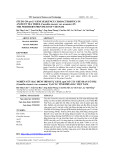
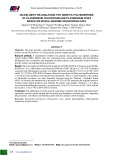


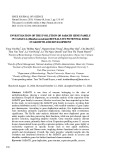
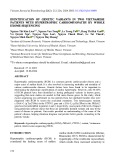


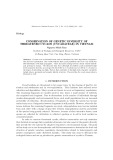
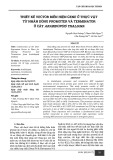



![Bài tập Đa dạng thế giới sống [kèm đáp án/ hướng dẫn giải]](https://cdn.tailieu.vn/images/document/thumbnail/2025/20251123/thaohoang9203@gmail.com/135x160/5861763951302.jpg)











